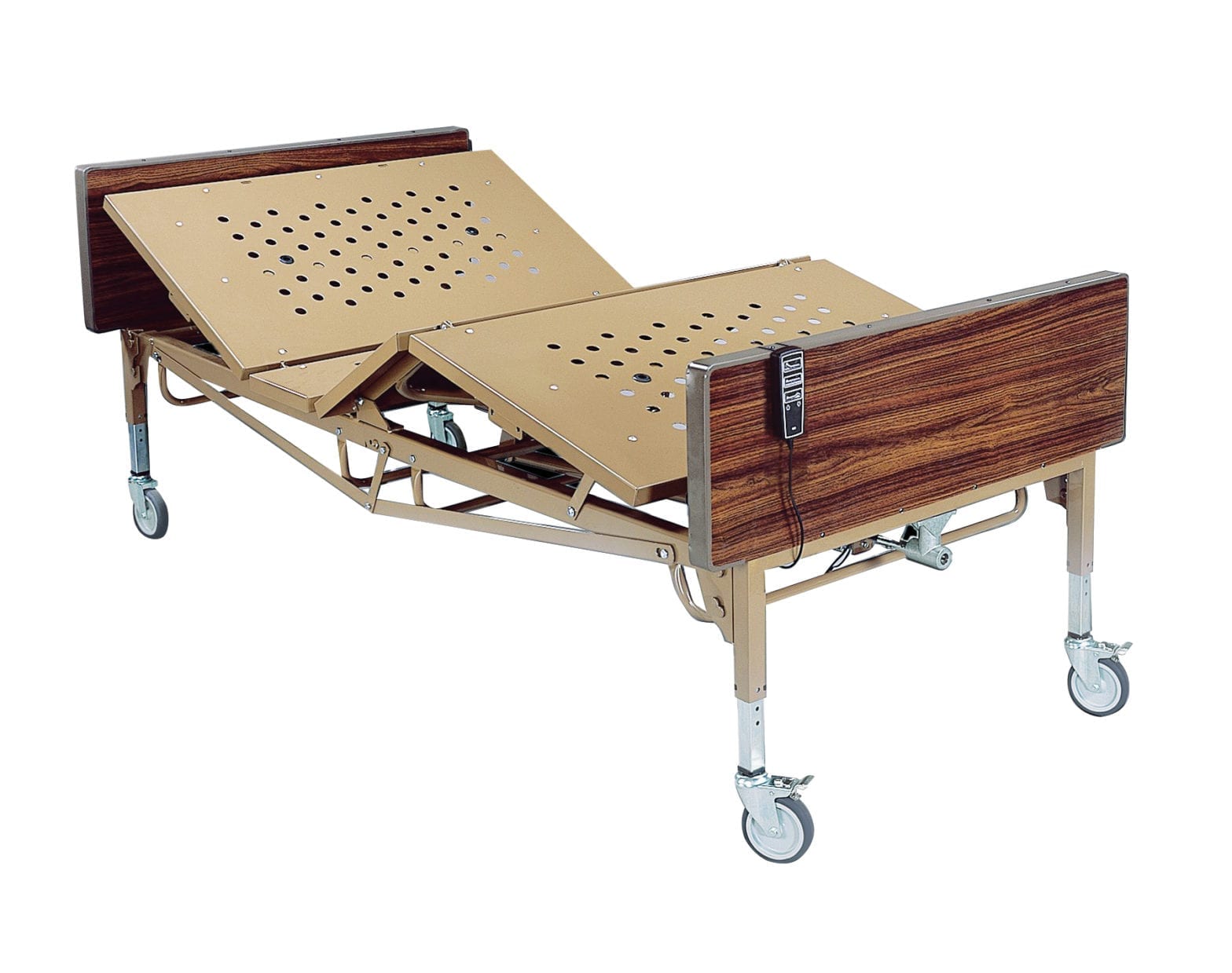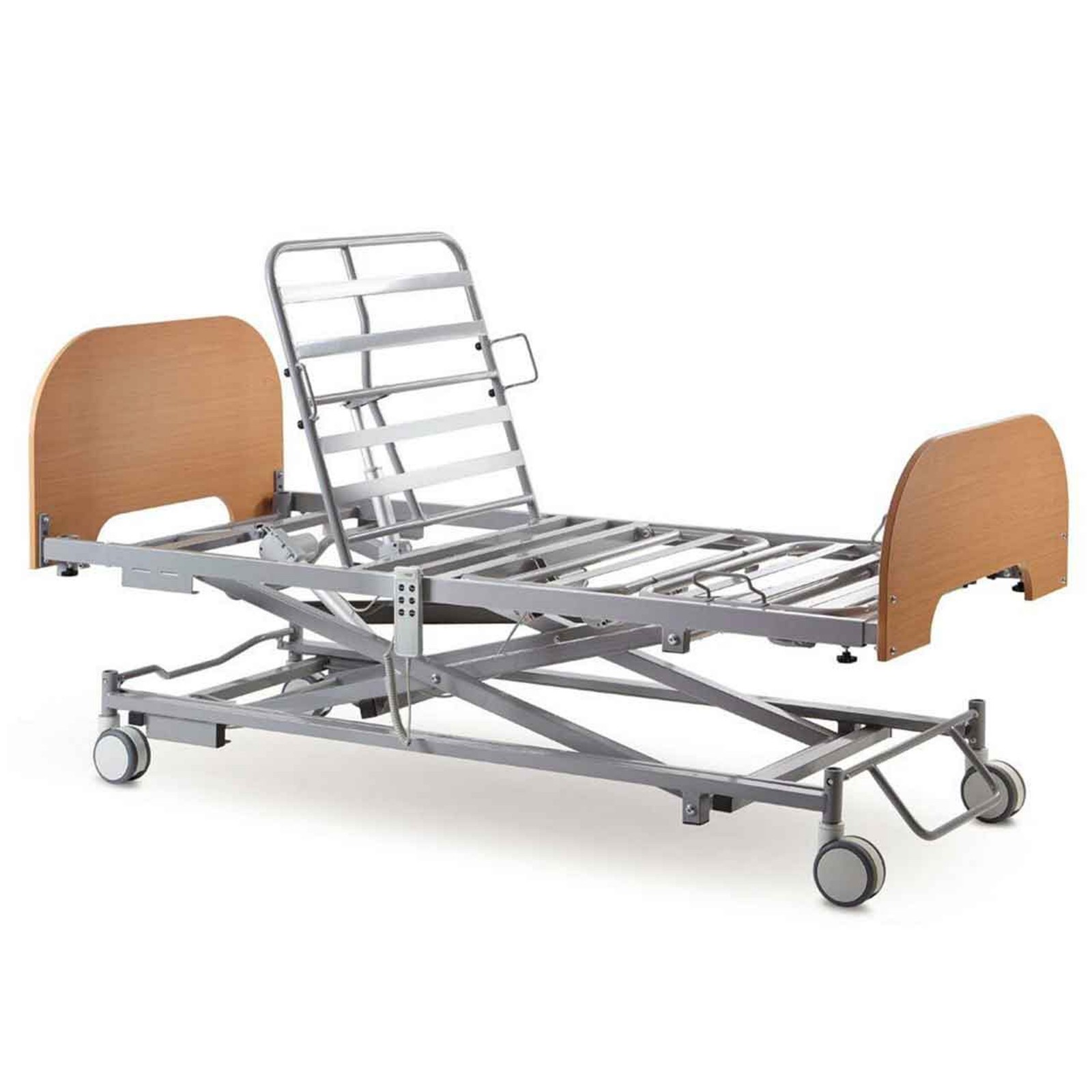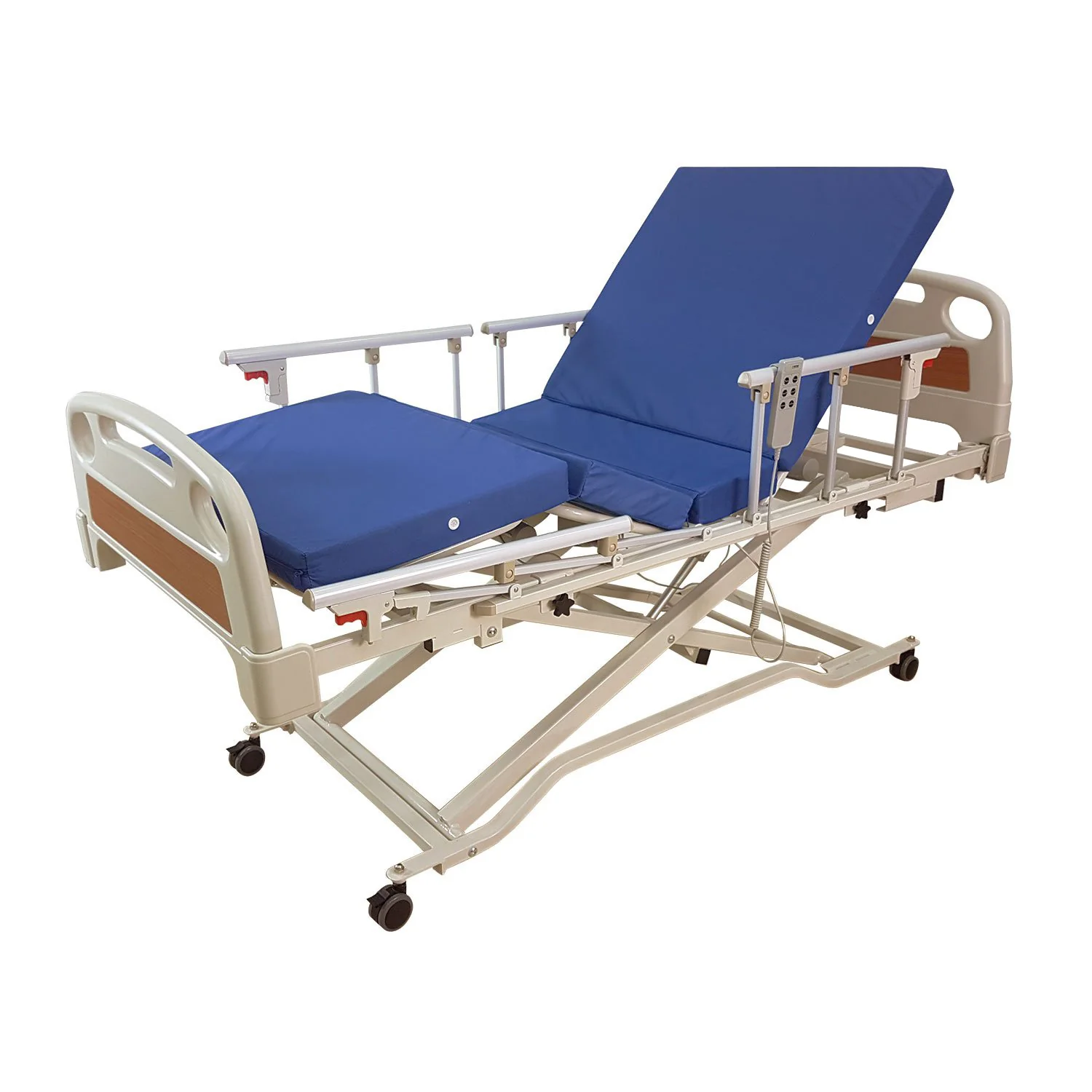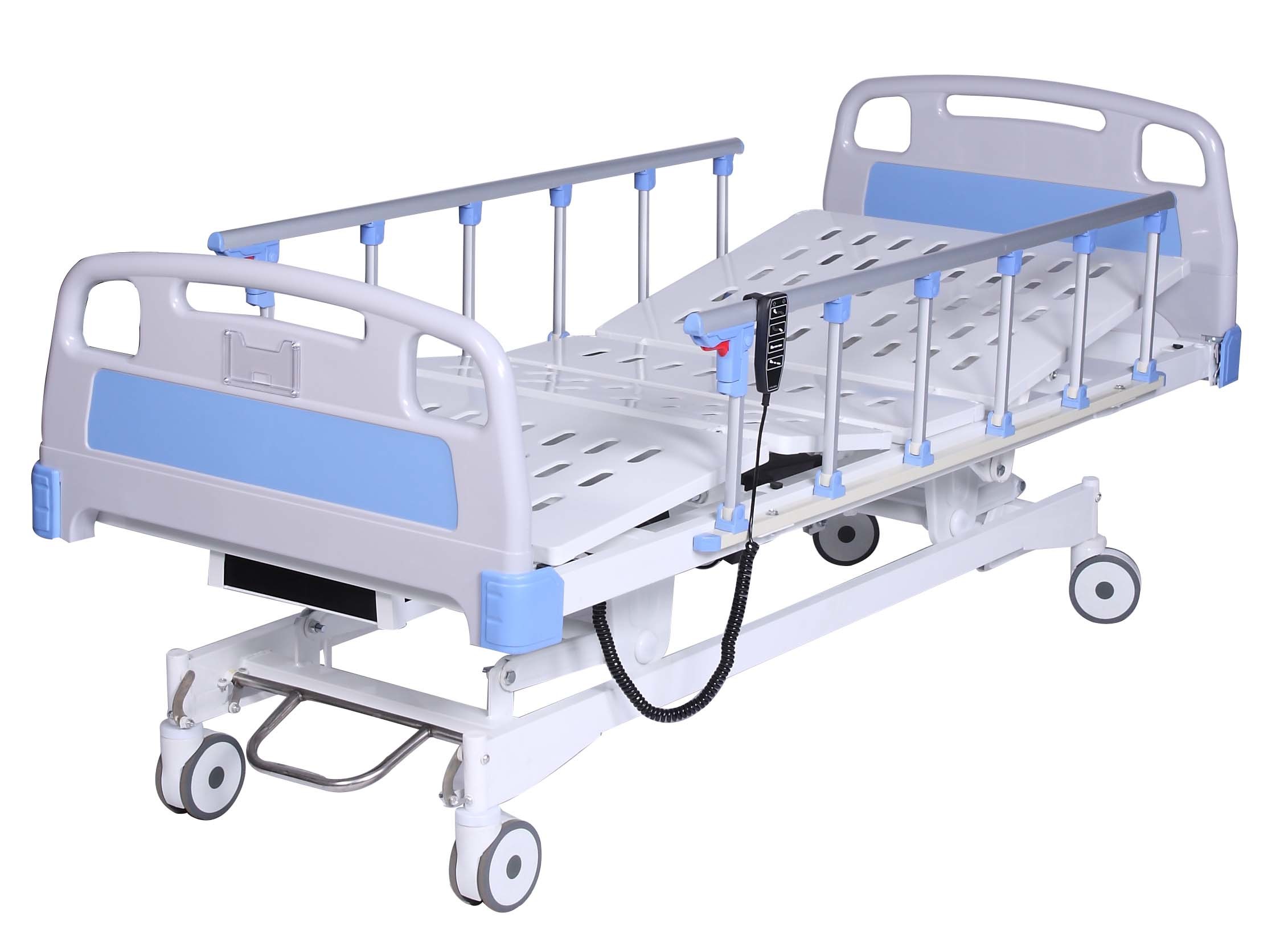
Adjustable Hospital Bed Vs. Electric Hospital Bed: What's The Difference?
2024-08-26 15:30
In home care, rehabilitation care, and long-term care, choosing a suitable hospital bed becomes particularly important. In the market, the choice of hospital beds mainly focuses on two types: adjustable hospital bed and electric hospital bed. However, many people often face confusion when purchasing and don't know which type of bed to choose. What is the difference between them? Which one is more suitable for specific care needs?
This article will explore the difference between adjustable hospital bed and electric hospital bed in depth to help you make an informed choice.

What Is an Adjustable Hospital Bed?
Before going into the comparison, let's first understand the definition of adjustable hospital bed. Adjustable hospital bed, as the name suggests, refers to a bed that can adjust the height, inclination, and posture of the bed according to the needs of the user. Usually, this type of bed is equipped with a manual or electric adjustment system that allows the user to adjust the height of the head and foot of the bed and the inclination angle of the overall bed.
Adjustable hospital beds are widely used in hospitals, rehabilitation centers, and home care environments. They are designed to improve patient comfort, reduce the workload of caregivers, and help patients more easily perform various activities during rehabilitation, such as eating, resting, sleeping, and receiving treatment.
Adjustable Hospital Beds Generally Have the Following Adjustment Features:
● Height adjustment at the head and foot of the bed: Allows the user to raise or lower the head or foot of the bed to find the most comfortable position.
● Tilt of the entire bed: Some adjustable hospital beds can tilt the entire bed, which is very useful for improving blood circulation, relieving pressure points, and helping patients with respiratory diseases.
● Height adjustment: Some beds are also equipped with a bed height adjustment function, which makes it easier for caregivers to provide care for patients and helps patients get in and out of bed more easily.
In short, the core function of an adjustable hospital bed is that it can be adjusted according to different needs and scenarios, providing flexibility and comfort.
The Importance of Understanding the Difference Between an Adjustable Hospital Bed And an Electric Hospital Bed
When facing the decision to buy a hospital bed, it is crucial to understand the difference between an adjustable hospital bed and an electric hospital bed. This not only affects the user's comfort and care effect, but is also directly related to the convenience of use, the functionality of the bed, and the overall care experience. Choosing the right bed can not only improve the patient's quality of life, but also reduce the work pressure of caregivers.
First of all, health status and care needs are important factors in determining the choice of hospital beds. If the patient is bedridden for a long time or needs to adjust his/her position frequently, then an electric hospital bed may be more suitable because it can adjust the bed more easily and reduce the inconvenience caused by manual operation. If the patient can move independently and only needs to adjust the bed occasionally, then an adjustable hospital bed may be sufficient.
Secondly, the use environment is also an important aspect to consider. The needs of home care and hospital environments may be different. In hospitals, electric hospital beds are used more frequently and require more adjustment, while at home, caregivers and patients may prefer adjustable hospital beds with slightly simpler functions and relatively convenient operation.
Finally, budget and economic conditions should not be ignored. Electric hospital beds are usually more expensive and have more complex functions, while adjustable hospital beds provide more choices in price and function. Understanding the difference between the two can help consumers find the most suitable bed within their budget and avoid unnecessary expenses.
Therefore, before purchasing, a deep understanding of the differences between adjustable hospital beds and electric hospital beds can allow you to make a choice that is more in line with actual needs, which not only meets the patient's care needs but also ensures economic rationality.

Adjustable Hospital Bed Vs. Electric Hospital Bed: Differences in Use
There are significant differences in the way adjustable hospital beds and electric hospital beds are used, which directly affect the convenience of care and the comfort of patients.
Usage Features of Adjustable Hospital Beds:
● Manual operation: Most adjustable hospital beds change the bed position by manual adjustment. Users or caregivers need to use mechanical handles or manual controls to adjust the height of the head and foot of the bed. This method is relatively simple, but it may be troublesome when frequent adjustments are required, especially for caregivers or patients with weaker physical strength.
● Strong adaptability: Adjustable hospital beds are usually simple in structure and suitable for home care and mild care needs. Their design enables users to make basic posture adjustments without relying on electricity, which is suitable for temporary or short-term care.
● Cost-effectiveness: Due to the simpler mechanical structure of adjustable hospital beds, they are usually more affordable and are the first choice for many families or medical institutions with limited budgets.
Usage Features of Electric Hospital Beds:
● Electric control: Electric hospital beds are equipped with an electric adjustment system, and users can easily adjust the bed position through a remote control or bedside control panel. This electric operation greatly simplifies the nursing process, especially for patients who need to adjust their posture frequently.
● Versatility: Electric hospital beds are usually equipped with more advanced functions, such as memory settings, one-button reset, night lighting, etc. These functions not only improve the comfort of users, but also further simplify the work of nursing staff.
● Nursing optimization: Electric hospital beds are simple and fast to operate, which is especially important for patients who are bedridden for a long time. They can help patients find a comfortable posture faster and reduce pressure sores or other complications caused by long-term immobility.
In summary, adjustable hospital beds are more suitable for occasions with lower nursing needs, while electric hospital beds are designed for patients who are bedridden for a long time and need frequent posture adjustments. The difference in the way they are used determines their respective scope of application.
Adjustable Hospital Bed Vs. Electric Hospital Bed: Difference in Bed Size
The size of the bed is directly related to the comfort of the patient and the convenience of nursing. Adjustable hospital beds and electric hospital beds also differ in bed size, mainly in the adjustment range of width, length and height.
Dimensional Features of Adjustable Hospital Bed:
● Width and length: adjustable hospital bed usually adopts standard size, with width generally ranging from 36 to 39 inches (about 91 to 99 cm) and length ranging from 80 to 84 inches (about 203 to 213 cm). These sizes are suitable for most adult patients and can provide enough space to meet basic sleeping and nursing needs.
● Height adjustment: The height adjustment range of adjustable hospital bed is relatively limited, and the height is generally between 15 and 23 inches (about 38 to 58 cm). This height is suitable for most nursing occasions, but it may be slightly insufficient in some special nursing needs.
Dimensional Features of Electric Hospital Bed:
● Diversity of width and length: The size of electric hospital bed is usually more diverse. In addition to standard sizes, widened or lengthened versions are also available to accommodate patients of different sizes. For example, the width of some electric hospital beds can reach 42 to 48 inches (about 107 to 122 cm), and the length can be extended to 88 inches (about 224 cm) or longer. These widened and lengthened versions provide patients with more room for movement and comfort.
● Flexibility of height adjustment: The height adjustment range of electric hospital beds is usually larger, and the height of some advanced electric hospital beds can be adjusted between 10 and 30 inches (about 25 to 76 cm). This flexibility of height adjustment is not only convenient for nursing staff to operate, but also helps patients get in and out of bed more easily.
The difference in bed size reflects the difference in design concepts between adjustable hospital beds and electric hospital beds. Adjustable hospital beds usually focus on the realization of basic functions, while electric hospital beds tend to provide a variety of options to meet the personalized needs of different patients.

Adjustable Hospital Bed Vs. Electric Hospital Bed: The Difference in Bed Inclination
Bed inclination is a key factor in hospital bed design, which directly affects patient comfort, blood circulation, airway patency and the effectiveness of preventing pressure ulcers. There is a significant difference between adjustable hospital bed and electric hospital bed in the ability to adjust the bed inclination.
The Inclination Characteristics of Adjustable Hospital Bed:
● Manual adjustment: Adjustable hospital beds usually use mechanical handles to manually adjust the height of the head or foot of the bed. Although these beds can achieve basic bed tilt, the range and accuracy of adjustment are relatively limited. Generally speaking, the maximum inclination angle of the head of the bed is between 30 and 45 degrees, while the inclination of the foot of the bed is usually smaller.
● Usage limitations: Due to the limitations of manual adjustment, the adjustable hospital bed may not be convenient enough in situations where frequent posture adjustments are required, especially when fine adjustments or rapid changes in bed posture are required.
The Inclination Characteristics of Electric Hospital Bed:
● Electric adjustment: The electric hospital bed is driven by an electric motor and can accurately adjust the inclination of the bed head, bed foot and the entire bed. The inclination angle of the head of the bed can usually reach 60 degrees or more, while the inclination of the foot of the bed can also be adjusted significantly as needed. This precise adjustment capability makes the electric hospital bed more suitable for patients with specific postural needs.
● Advanced adjustment functions: Some high-end electric hospital beds are also equipped with Trendelenburg (the head of the bed is lower than the foot of the bed) and reverse Trendelenburg (the head of the bed is higher than the foot of the bed) functions. These functions can help patients improve blood circulation, reduce pressure points, and in some cases auxiliary treatment.
The ability to adjust the inclination of the bed is an important difference between an adjustable hospital bed and an electric hospital bed. For patients who need to change positions frequently or have specific care needs, the advantages of electric hospital beds are even more obvious.
Adjustable Hospital Bed Vs. Electric Hospital Bed: Manual Controller of the Hospital Bed
The design of a hospital bed's controller is critical to ease of operation and user experience. There are significant differences between adjustable hospital beds and electric hospital beds in how the manual controls are used.
Manual Controller for Adjustable Hospital Bed:
● Mechanical handle: Adjustable hospital beds are usually equipped with mechanical handles or rotating handles. Users can adjust the height and inclination of the bed by manually turning these devices. Although this control method is simple and durable, it can be laborious to operate, especially if frequent adjustments are required.
● Limited functions: Due to the design limitations of the mechanical controller, adjustable hospital beds usually can only provide limited adjustment functions and cannot achieve precise and diverse posture adjustments.
Manual Controller for Electric Hospital Bed:
● Remote control or panel control: The electric hospital bed is equipped with an electric controller, usually in the form of a remote control or bedside control panel. Users can adjust various parts of the bed with simple button operations without any effort. This control method greatly simplifies the operation process and is especially suitable for patients and caregivers with weak physical strength.
● Versatility: The controller of an electric hospital bed usually has multiple functions, such as memory settings, one-button reset, night lighting, etc. Users can customize the bed position according to their personal needs and quickly adjust it when needed.
The design of the manual controller directly affects the ease of use of the hospital bed. The electric controller of the electric hospital bed undoubtedly has obvious advantages in simplicity of operation and functional diversity, while the adjustable hospital bed is more suitable for users who pursue simplicity and durability.
Adjustable Hospital Bed Vs. Electric Hospital Bed: Design is Crucial to Hospital Beds
The design of hospital beds is not only for aesthetics, but also to meet the needs of different patients and ensure comfort and safety. Adjustable hospital bed and electric hospital bed also have different emphases in design concepts.
Design Features of Adjustable Hospital Bed:
● Simple and practical: The design of adjustable hospital beds usually focuses on simplicity and practicality, with relatively simple functions but sufficient to meet basic nursing needs. Their construction is sturdy and durable for long-term use in a variety of care settings.
● Cost-effectiveness: The design of the adjustable hospital bed focuses on cost control while satisfying basic functions, making it suitable for users or medical institutions with limited budgets.
Design Features of Electric Hospital Bed:
● High-end functions: The design of electric hospital beds often pursues the realization of high-end functions, not only focusing on comfort, but also optimizing operation convenience and user experience. The design concept is to provide a comprehensive care solution.
● Personalized design: The design of the electric hospital bed pays more attention to individual needs and provides a variety of adjustment modes and additional functions to meet the special care requirements of different patients.
The difference in hospital bed design reflects the difference in market positioning between adjustable hospital beds and electric hospital beds. The former is more suitable for users who pursue practicality and durability, while the latter is aimed at user groups who require high-end functions and personalized services.

What Are The Benefits of Adjustable Hospital Bed?
The price of adjustable hospital beds is usually relatively affordable, making it a very practical choice for families or institutions with limited budgets. Due to its relatively simple structure, adjustable hospital beds usually do not require complex maintenance or operation and can be used normally even without electricity. The mechanical structure of adjustable hospital beds is generally more durable and suitable for long-term use, especially in multi-user environments such as hospitals or care centers. In addition, adjustable hospital beds are suitable for a variety of care settings, especially in short-term care or respite care, where their flexibility and ease of use are particularly outstanding.
In general, the benefits of an adjustable hospital bed lie in its economy and durability, making it suitable for users who do not need to frequently adjust their posture or have low functional requirements for the bed.
Are Hospital Beds Considered Medical Equipment?
When discussing hospital beds, a common question is: Are hospital beds considered medical equipment? This not only affects the purchase decision of hospital beds, but also relates to insurance reimbursement and legal supervision issues.
Definition of Medical Device:
According to the medical regulations of most countries, hospital beds (especially those with adjustable functions) are generally classified as medical equipment. This is because these beds are designed for specific medical purposes, such as assisting in recovery, alleviating disease symptoms, or improving a patient's quality of life.
Insurance Reimbursement:
In some cases, the purchase of a hospital bed may be reimbursed through Medicare if a doctor writes a prescription stating that the bed is necessary for the patient's recovery or care. Electric hospital beds are generally more likely to be regarded as medical equipment due to their high-end functions and complexity, while adjustable hospital beds may need to be judged based on specific functions and usage scenarios.
Legal Supervision:
As medical equipment, hospital beds usually need to comply with relevant laws, regulations and standards during production, sales and use. This includes requirements for material safety, functional testing, usage guidance, etc. Consumers should choose certified products when purchasing to ensure their safety and effectiveness.
Knowing whether a hospital bed is considered a medical device can help consumers make more informed decisions when purchasing, especially when it comes to insurance reimbursement and legal compliance.

Adjustable Hospital Bed Vs. Electric Hospital Bed, Which One is Best for Me?
If you need to adjust your posture frequently and want easy operation, the electric hospital bed is undoubtedly the best choice. They offer advanced features that increase patient comfort without increasing the burden of care. If you have a limited budget and do not have high requirements for bed adjustment functions, an adjustable hospital bed may be more suitable. Their affordability and durability make them ideal for home care and short-term care.
For long-term bedridden patients, the advanced features of the electric hospital bed can significantly improve quality of life, reduce the risk of pressure ulcers, and make it easier to quickly adjust the bed position in an emergency. For temporary or short-term care needs, an adjustable hospital bed provides enough flexibility and convenience without the high cost of an electric hospital bed.
In short, choosing a suitable hospital bed is not only a comparison of functions and prices, but more importantly, a comprehensive consideration based on specific nursing needs and usage scenarios. Whether it is an adjustable hospital bed or an electric hospital bed, each has its own advantages and scope of application. The correct choice can greatly improve the quality of care and the patient's life experience.








